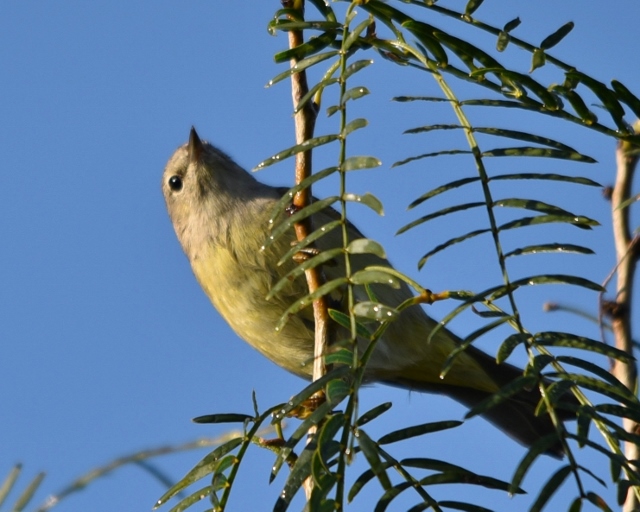Story and photos by Anita Westervelt, Texas Master Naturalist

Lucky is the yard that attracts winter-visiting feathered friends. It’s not hard to do: native honey mesquite, Texas Ebony, Mexican ash and live oak are popular insect-attracting trees which in turn beckon birds that are permanent residents, winter residents and those just passing through.
A tiny, nearly tree-branch-colored bird less than four inches long, that darts, hops and swoops so quickly you’re not sure you saw it, is a blue-gray gnatcatcher. Described as graceful, delicate, miniscule and twitchy, it’s always in motion. It winters in the very southern tip of Texas although its permanent residence is just south, west and a bit north of the Valley and along the coast of the Gulf states and then up the eastern seaboard to the Carolinas. Some may breed in our area.

Blue-gray gnatcatchers frequent the outer branch tips of trees; they will spread their tail and flick it from side to side, raising insects to catch in flight. They also skit about on leaves to eat spiders and other invertebrates, like treehoppers, beetles, caterpillars, grasshoppers and insect eggs and larvae. The male has bluish-gray upper parts and whitish underparts. The female is a paler blue-gray also with light underparts. Both sexes have a white eye ring; the male has a black line on each side of its crown.

Another bird that seems to be visiting in droves this year is the orange-crowned warbler. Its summer home is Canada and western United States up to Alaska. They winter over from southern California through most of Texas, along the Gulf Coast states and south into Mexico. They are a bit larger than the blue-gray gnatcatcher with a length of five inches. They are easier to spot with their brighter colors — especially with their yellowish-green to olive green underparts. The orange crown is rarely visible unless the bird is excited and raises its head feathers.
Orange-crowned warblers eat ants, beetles, spiders, flies and caterpillars. They poke and flit from the ground to the treetops as they forage for food. They also will eat fruit, berries and seeds and will pierce the base of flowers to get nectar.
If you have a knack for spotting birds and enjoy counting and collecting data, the annual Backyard Feeder Watcher portion of Audubon’s 121st annual Christmas Bird Count is nearing.
Backyard Feeder Watchers can help count birds without leaving home. It can be a solo activity for those who choose to continue to isolate.
The Valley is segmented into different areas with different compilers and count dates. Please contact a compiler that corresponds to your area prior to count day to get more information and a bird list for easy data logging.
Santa Ana — December 19, SantaAnaCBC@gmail.com.
Laguna Atascosa — December 28, markhconway@hotmail.com.
Falcon — December 30, pfoster1@stx.rr.com.
Anzalduas/Bentsen — January 2, 2021, Roy.Rodriguez@tpwd.texas.gov.
Harlingen — January 2, 2021, hgtxcbc@gmail.com.
Kingsville — January 2, 2021, sinclairjim@yahoo.com.
For more information, visit feederwatch.org.

